Eastern Hokkaido: Epic Year-Round Outdoor Adventure in Northern Japan
Hokkaido, the northernmost main island of Japan, is a place of breathtaking vistas and diverse habitats for wildlife observation. Its eastern half, bordered by the Sea of Okhotsk to the north and the Pacific to the east, is home to the Shiretoko World Natural Heritage site as well as three national parks. These protected lands offer the opportunity to encounter rare flora and fauna in places of great beauty while enjoying a myriad of outdoor activities throughout the year. Walk the trails of brown bears in wild forests, listen for the call of the globally endangered Blakiston’s fish-owl, or seek out the Steller’s sea eagle soaring high on thermals. Paddle Japan’s largest caldera lake, climb an active volcano, behold a salmon run, and even bob like a seal on ice floes. Take home a new skill or insight received from a member of the indigenous community—all this and more is possible.
Here we focus on three areas within eastern Hokkaido around which to plan your visit: the Shiretoko peninsula in the northeast, Mashu Kussharo southwest of that, and Akan, in the region’s center. While winters are long and summers are short in this part of Japan, this means all the more opportunity for robust outdoor fun year-round. Three regional airports offer direct flights to eastern Hokkaido from Tokyo and Sapporo areas, making access to this wild playground easy. Hire one of the region’s many knowledgeable nature guides to facilitate on-the-ground logistics and deepen your experience of all this region has to offer.
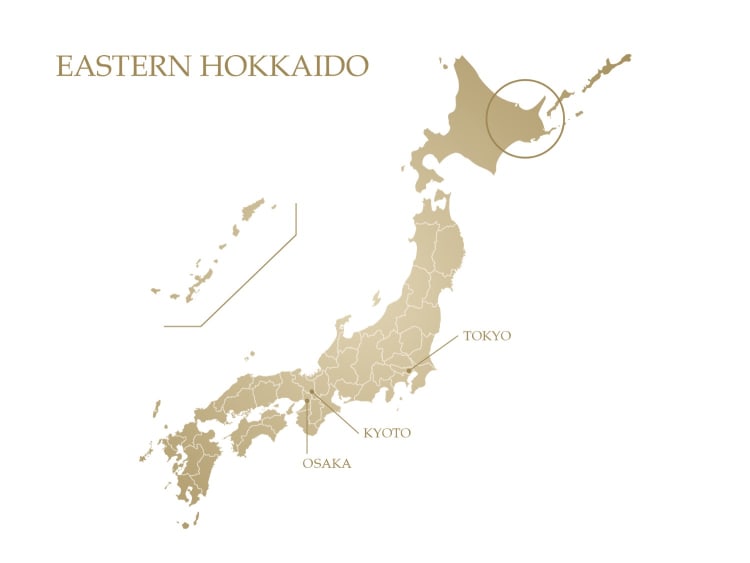
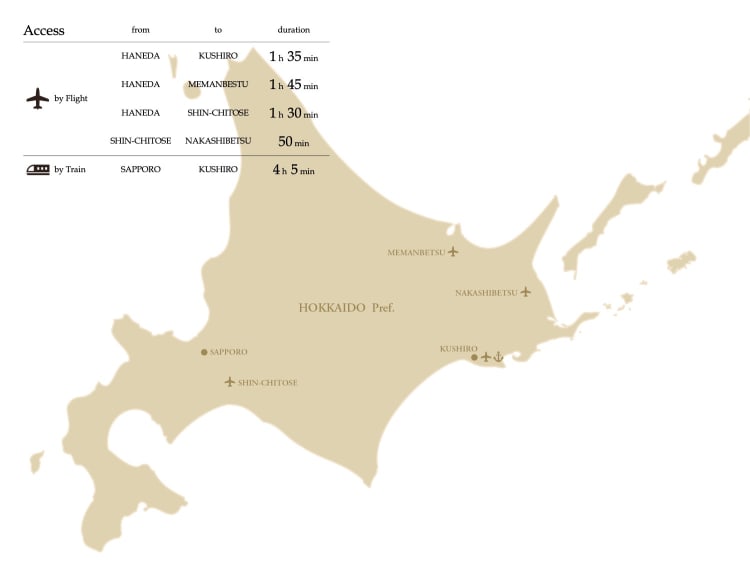
A Trio of Areas, a Multitude of Experiences
Shiretoko
A literal mosaic of natural features awaits on Shiretoko, the peninsula at Hokkaido’s northeastern end. This long narrow corridor is 70 km in length and 25 km wide, and nearly half of it is national park. A volcanic mountain range rises steeply along its spine, dominated by the 1,661-meter Mt. Rausu. The land is covered in forests of Mizunara oak and fragrant Ezo spruce and Sakhalin firs and, at higher elevations, birch and dwarf pine. Wild cherries bloom from mid-July to August, bringing delicate grace notes to rocky outcroppings. Take in Shiretoko’s natural beauty from the vantage of the water on a boat cruise as well as on forest treks and cascade climbs.
Thanks to a confluence of temperature, salinity, and topographical conditions, Shiretoko’s western coast, facing the Okhotsk Sea, is the lowest reach of the northern hemisphere where seasonal drift ice forms. The nutrient-rich water carried in these floes supports a diverse marine environment, which in turn sustains food sources for terrestrial animals including the brown bear and the globally threatened Steller’s sea eagle and endangered Blakiston’s fish-owl, the largest of their kind found in Japan. The ocean’s health is the forest’s health, and vice-versa: nutrients and sediment flow from land to sea, too, shaping the marine ecosystem by regulating water quality, providing food for phytoplankton, and stemming erosion. Rivers and estuaries bridge this intrinsic connection.
In the April–September season you can start your day seeking out whales or brown bears, then spend the afternoon trekking through woodlands or taking in the breathtaking views of the Shiretoko Goko Lakes (five lakes) area. Have binoculars at the ready for Ezo sika deer, northern foxes, Ezo red squirrels, and a variety of songbirds and other feathered residents. Nighttime tours of Shiretoko’s forests add yet another level of wonder to the sightings in store.
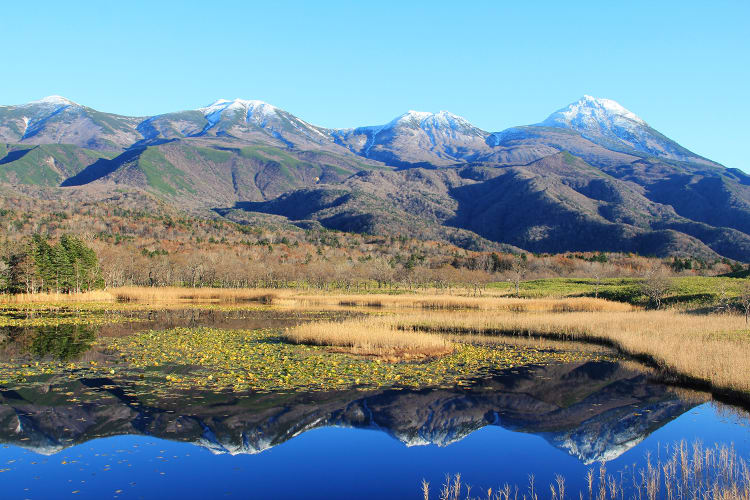
Shiretoko Goko Lakes
Between July and September, strap on water shoes and climb the Kamuy-Wakka thermal cascade north of the Shiretoko Goko Lakes. The water temperature is a cool 25℃ at the outset, then gradually increases to about body temperature at the finish point. In the December–March winter season, you can snowshoe your way to Furepe Waterfall, identifying animal tracks along the way. In February and March you can walk, float, and bob among Hokkaido’s famed ice floes that originate as far away as the mouth of the River Amur in northeast Asia. Don a dry suit that will keep you warm and dry even in sub-zero temperatures, then enter a winter wonderland experienced by few. Sea eagles, seals, and shell-less “sea angel” mollusks are among the wildlife large and small you may see. No matter the season, and whether you opt for a morning, afternoon, or full-day tour, certified guides will color your excursion with their deep knowledge of the area’s plants, animals, and local lore.
Mashu Kussharo
The Mashu Kussharo area is home to Lake Mashu, enclosed by 200-meter rock walls and renowned for its clarity, and Lake Kussharo, the second largest caldera lake in the world after Lake Toba in Indonesia. Its present-day terrain, like that of Akan to the west, was formed by volcanic eruptions 150,000 to 200,000 years ago.
Swim, canoe, SUP, kayak, and fish on Lake Kussharo or the Kushiro River, the pristine tributary that flows from it. The warmer months are a likely time to encounter the scenic phenomenon known as unkai, “sea of clouds.” This early-morning weather magic fills the lake basin with a swirling white spectacle of fog and mist. Autumn travelers will find a tapestry of orange and yellow that peaks around mid-October. In early November, when the broadleaf trees are bare, the golden leaves of coniferous larch paint the hills. This is also high time for birdwatching. Though winter is harsh, it, too, is a time of great scenic—even poetic—beauty. The darkened boughs of trees glisten with ice crystals, so-called diamond-dust sparkles in the air, and frost flowers bloom on the lakes. Canoe tours of Kushiro River operate year-round; a winter paddle of its headwaters with the snowy landscape of frost-covered trees all around is a sight to behold. End your day with a night hike under the broad starry sky.
Whether you call it “Naked Mountain,” as do the Ainu, or “Sulfur Mountain,” as do the Japanese, the rocky terrain of Atosa-Nupuri (Mt. Io), an active volcano, packs some power. Take a three-hour trek to see fumaroles venting plumes of steam, lava domes, the remains of a mine, and the massive Kumaotoshi (“Bear Trap”) crater, believed to have been blown from an explosion four centuries ago. Along the way learn about the origins of the Kussharo caldera and the history of sulfur mining here. Development of this trekking route earned the town of Teshikaga “Green Destination” recognition for best practices in sustainable tourism; your visit will contribute to environmental conservation on the mountain.
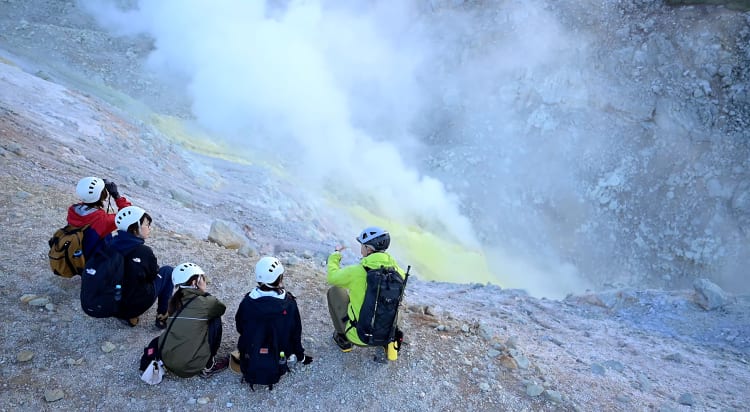
Atosa-Nupuri Trekking Tour
Akan
The route from the Mashu Kussharo area to Akan and its eponymous caldera lake has lookout points offering magnificent views of eastern Hokkaido’s peaks, lakes, and forested land. The hot-spring town on the southern shore of Lake Akan is the only settlement on this body of water—all around is wilderness. This makes it an excellent base for activities: canoeing, cycling, hiking, and trekking can all be enjoyed with the assistance of certified guides. Lake Akan lies between Mts. Meakan (1,499 m) and Oakan (1,370 m), considered female and male counterparts, respectively, in local lore. Meakan, the more active volcano of the two, is the highest peak in Akan-Mashu National Park.
Sakhalin fir and spruce and Ezo spruce fill Akan’s forests, with rhododendrons in the undergrowth. The brown bear, northern fox, Ezo sika deer, red squirrel, and many bird species reside there, while the lake is famous for its marimo, a rare spherical algae that in the right conditions can grow as large as 30 cm in diameter. Ride a boat to the observation center at the lake’s northern end to learn about ongoing conservation efforts.
Akan is home to a vibrant Ainu community, offering many ways to learn about indigenous arts new and old. Try your hand at one of the embroidery or wood-carving classes taught by Ainu residents, or take an easy stroll through the woods with an Ainu guide. There are dozens of shops and galleries, and a theater for Ainu dance and performance art. As you explore the town and its lake and woodlands, keep an eye out for koropokkur, the local folklore equivalent to faeries or leprechauns.
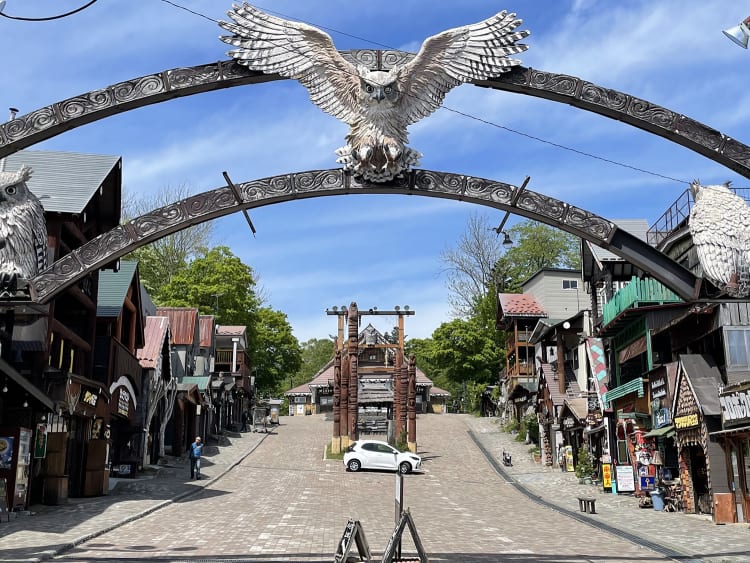
Akanko Ainu Kotan, Ainu village
The untouched beauty of the Lake Akan area is owed in part to the conservation efforts by the Akan-based Maeda Ippoen Foundation and its ongoing silviculture practices. With a guide you can hike Hikari no Mori, a woodland managed by the foundation, to see a centuries-old Judas tree with a girth of more than six meters, as well as gurgling mud pots and, in the warmer months, many flowering plants. Listen for the calls of the black woodpecker, a year-round resident whose red crown makes it easy to spot.
Full-Service Resorts, Private Villas, and Country-Style Auberges
In Shiretoko, the Kitakobushi Shiretoko Hotel & Resort at the gateway to the World Natural Heritage site offers all the customary comforts of resort relaxation. Enjoy vibrant seafood meals overlooking the Sea of Okhotsk, and choose from both Japanese and Western-style rooms, some with private hot-spring baths. The grand baths on the penthouse floor have ocean views. Watching the drift ice beyond the sauna window is a winter luxury you won’t soon forget. Lantern SHIRETOKO, accommodating up to 16, is a fully equipped four-bedroom rental facing the sea. Get your own provisions as residents do and settle in as if it were home, complete with a wine cellar and a wood-fired sauna.
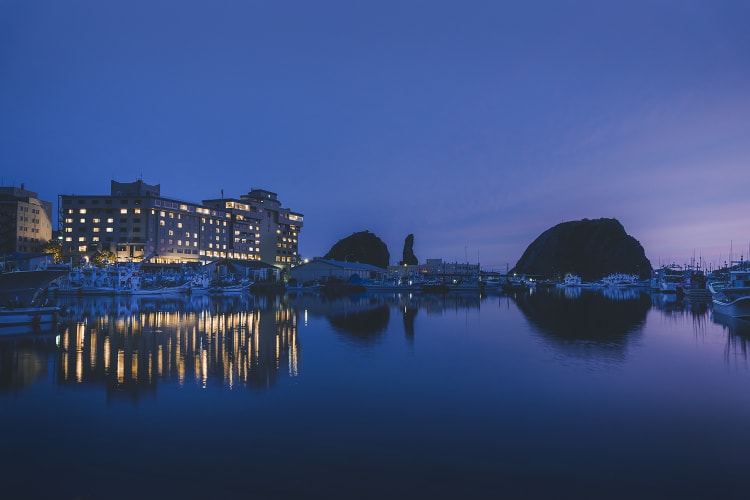
Kitakobushi Shiretoko Hotel & Resort
A number of individually spirited upscale lodgings can be found in Mashu Kussharo. WAKKANUPURI, which takes its name from the Ainu wakka (water) and nupuri (mountain), offers three private villas at the northeastern shore of Lake Kussharo. Soak in the hot-spring bath, canoe on the lake, unwind in front of a crackling fire. Locally sourced freshwater fish, seafoods, and Wagyu beef feature in the breakfast and dinner menus. The upscale TAPKOP—Ainu for hillock—is a two-bedroom villa on a vast three-hectare site near the headwaters of the Kushiro River, just a ten-minute walk from Lake Kussharo. The main bath opens directly onto forested land. SoRa, named for the deep-blue sky of summer, is a light-filled auberge on the southern shore of Lake Kussharo that takes special pride in its “slow food, slow life” approach to multicourse lunches and dinners.
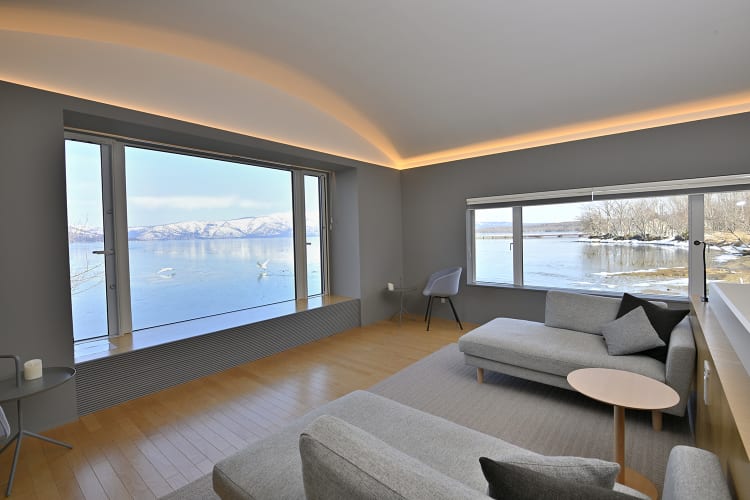
WAKKANUPURI
Tsuruga Resorts offers several kinds of accommodation in the Lake Akan hot-spring town; standout among them is the boutique-style Akan Tsuruga Bessou HINANOZA Each of its 25 suites boasts an outdoor bath, and most offer full-on views of the lake. In-room spa service brings the luxury of facials and full-body treatments right to your door. Unwind in the stylish bar or listening room with wine or a house-made liqueur, and don’t miss Tsuruga’s gallery of works by local artists.
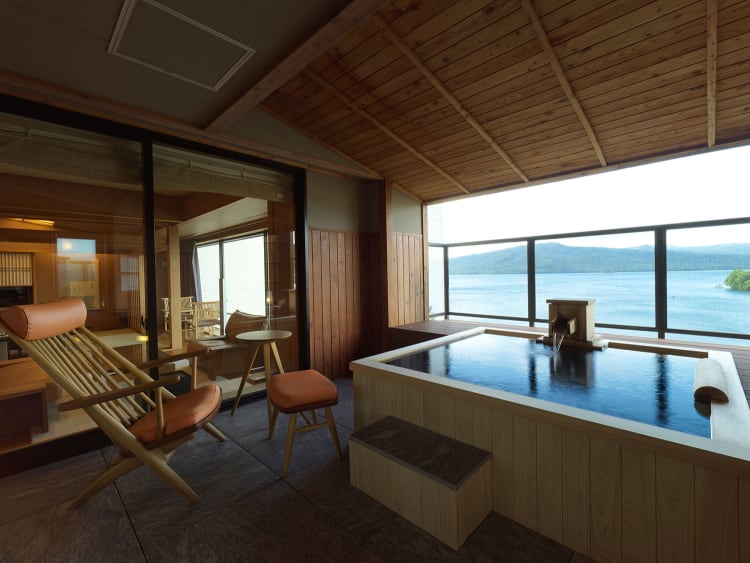
Akan Tsuruga Bessou HINANOZA

